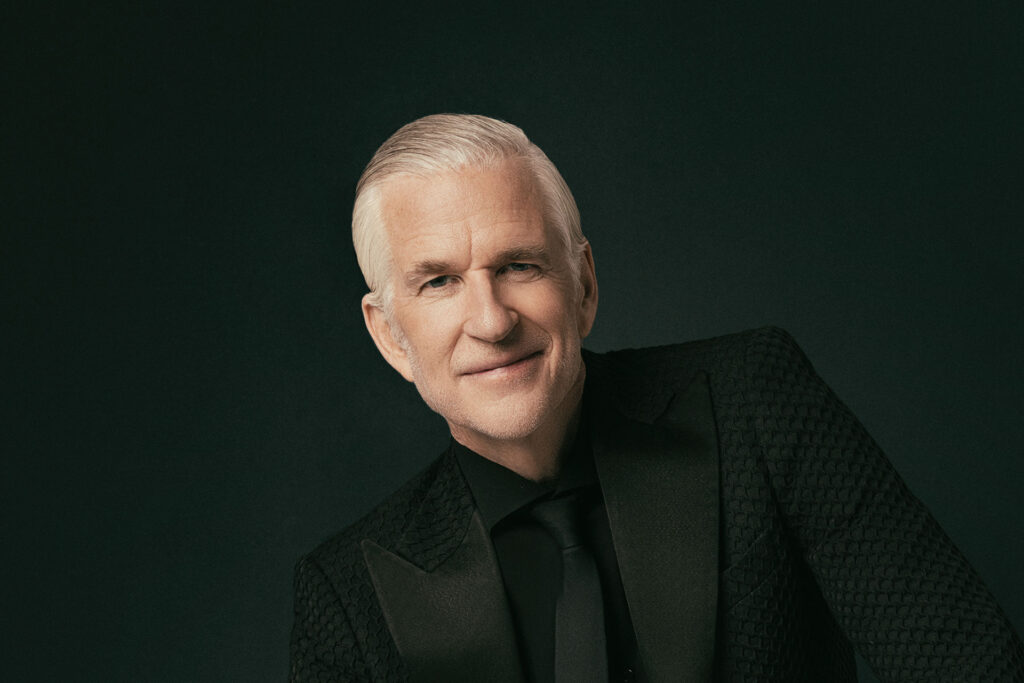The star of “Oppenheimer” and “Stranger Things”—and former Millbrook resident—is just now hitting his stride four decades into an extraordinary Hollywood career. Next up? Everything.
By Richard Pérez-Feria
Photography by Mike Ruiz
Matthew Modine/Madonna. Madonna/Matthew Modine.
For those of us in a particular generation, when Matthew Modine’s name comes up for whatever legitimate reason—his winning turn in the megahit Oppenheimer; his equal parts creepy-fascinating role as Dr. Martin Brenner in Stranger Things; his life-changing portrayal in Stanley Kubrick’s war masterpiece, Full Metal Jacket—we find it difficult to extricate the talented actor from the Material Girl because when they were both starting out, the movie Vision Quest forged them together in ways they may not yet fully understand.
Modine was the young (and impossibly handsome) lead of the 1985 film depicting a high school wrestler in Spokane, WA. Madonna, just then fully embracing the tsunami of attention directed at her, was in the film for what liberally could be called a cameo to perform the film’s theme song, “Crazy For You.” As it turns out, MTV, itself a new phenomenon that was hijacking most of American teenagers’ attention span, played the smash hit song’s video ad nauseam, on a perpetual, never-ending loop for months. Months. The video featured Madonna, of course, in character performing the pretty ballad (it became the icon’s second No.1 smash) and Modine in all his coltish handsomeness liberally, exhaustively on display. In my mind, Modine and Madonna are inextricably and effortlessly forever bonded.
When I bring up Madonna to Modine as we begin our conversation in earnest in the otherwise empty (nice) hotel restaurant in midtown Manhattan after a successful hours-long photo shoot, a smile slowly forms on the accomplished actor’s face. “Madonna…wow,” Modine whispers, leaning in closer to me. “It’s a testament to Madonna’s power as an entertainer that, for female artists, her presence is truly unmatched in our lifetime.” As I reveal my instinctual reasoning for connecting him to the game-changing superstar, his eyes get larger as he dives into a story.
“While I was filming Full Metal Jacket, I went to Rome during a break to meet two Italian brothers who were filmmakers named Paolo and Vittorio Taviani,” Modine says. “As I waited for them, I noticed a big poster that looked like Madonna in concert in Rome. The entire Vision Quest poster depicted Madonna who’s in the movie all of two minutes. Two minutes! [Laughs] They also changed the title of the film to Pazzo Di Te, which is Italian for ‘crazy for you.’ From that time forward, it became quite common for people to come up to me and say, ‘Oh, you’re in that Madonna movie.’ [Laughs] That’s Madonna.”
Modine, the youngest of seven children, grew up modestly in Loma Linda, CA—his mom was a bookkeeper, his dad managed drive-in theaters. I imagine that couldn’t have been easy for him being the seventh of seven kids. Was he all but ignored?
“That’s what happens with the first child,” Modine says, without a trace of resentment. “When the first kid gets a fever, you run to the hospital. The second child, you say, ‘Oh no, remember to put cold towels on his forehead.’ Then comes the third child, the fourth child, the fifth child, the sixth child—then… the seventh child, where parents say, ‘don’t worry, he’ll stop bleeding—he’ll survive.’ My son, as the firstborn, looks upon that experience I had as if I came from an abused childhood. He thinks I was bullied as a child. And perhaps I was by my older brothers who weren’t always the nicest to me. But I believe when you’re looking at a scar, you should really look at it. The scar is a sign of strength because you’re still alive—you survived it. I’m happy about the scars I have from my childhood because they made me who I am.”
Who Modine is today is arguably the busiest person in Hollywood. With a veritable battalion of projects premiering at breakneck speed, some of which he flatly can’t discuss due to the ongoing SAG-AFTRA actors’ strike decimating the current celluloid landscape. Inarguably, the current project that’s made the largest impact for Modine is Oppenheimer, the critically-acclaimed, global hit about the origins of the atomic bomb. Other films are out or, hopefully, imminent including roles in films Retribution (with Modine’s closest friend, Liam Neeson, playing hero) and The Martini Shot; must-see documentaries Accidental Truth: UFO Revelations and Downwind; and perhaps most exciting for us, I Am What You Imagine, a thought-provoking short film Modine directed that utilizes sound, music and expressionistic imagery to take viewers on a vivid journey to be featured at Woodstock Film Festival (September 27-October 1).
With so much creative gas clearly still in the tank, I ask the funny, kind man sitting across from me to share his origins story. Just how did Loma Linda’s Matthew Modine become award-winning actor Matthew Modine? Did his dad’s job running drive-in theaters play into his decision to pursue acting as a profession?
“I don’t think so,” he surprises me with his quick reply. “I wouldn’t articulate it that way. As a child, I thought films were documentaries and that everything that was happening on the screen was real. And then I saw this documentary about the making of Oliver and saw that the children were learning how to sing and dance. I realized then that acting was something that somebody learned how to do, and you did it in front of a camera. ‘Oh, that’s what I’m supposed to be doing.’ So, I started taking tap dancing lessons in Orem, UT and I joined the glee club. I was doing what Ryan Gosling was doing, but I wasn’t a member of The Mickey Mouse Club.” [Laughs] I then saw Little Big Man with Dustin Hoffman. And I was going to school with a lot of youth and Navajo Indians from the reservation. And as I was watching this movie, and the first time they pivoted the camera from the white settlers being attacked by natives, to indigenous people being killed by an American soldier—the point of view was changed—and it changed my point of view on life. That’s the power of film. I wanted to be an actor when I saw the impact that film could have. It certainly made an impact on me.”
He pauses for a beat or two, looking out to the bustling, silent (to us) maelstrom that is New York City at rush hour before continuing.
“My uncle somehow convinced me that if I wanted to be an actor, I should go to Brigham Young University, a Mormon school in Utah,” Modine says. “After a couple of weeks there, I said, ‘What the fuck am I doing here?’ [Laughs] So, I got out of there—fast. I then went to Salt Lake City where I worked for a concert promoter until I could save enough money to be able to drive back to San Diego where my parents were now living. As I was driving my old Volkswagen across the desert—without having checked the oil before venturing out—the engine gave out. I called my dad and said, ‘My car broke down. I’m out in the desert. What should I do?’ My dad said, ‘It sounds to me like you ought to get a fucking job.’ So, I did.”
The relative ease which Modine ascended was comparable to some of his über-famous male contemporaries who include Sean Penn, Kevin Bacon and, the biggest star of them all, Tom Cruise. “He carved his own path through the woods,” Modine says of Cruise. “It’s a real testament to his marketing ability.”
I’ll tell what’s not a testament to Modine’s marketing ability are the trio of films—epic, mind-blowing, blockbuster, ridiculous, once-in-a-lifetime movies—he turned down. Wait for it: Top Gun. Back To The Future. Big. He turned them all down. All. Of. Them.
“Well, yeah… Big was a mistake,” Modine says, not exactly laughing. “I passed on Top Gun because the script was just creepy. Frankly, it was so jingoistic and terrifying. The script was a commercial… or military porn. But you know, Tom Cruise made it engaging. Anyway, passing on Big was a mistake because Big was big—gigantic. My wife really tried to talk me into it. And I didn’t take her advice. Truth is, I was simply looking too deep into the script and the role. I’d studied with [legendary acting coach] Stella Adler and one of the things that she was great at was script interpretation. And so, what you really wanted to do whenever you were reading a script was to try to understand the whole backstory. What happened before the character walked into the room? What was the character’s motivation? How did I get here today to sit down with you? Big read as an epic story about 1980s materialism and about a child who wants to be big only because he wants to be old enough to go on carnival rides that he’s too small to go on. He wants money. He wants power. ‘I wish I was big!’—that was literally ’80s materialism. I mean, the whole scene of the kid buying all the basketball hoops when he becomes big wasn’t for me, it just wasn’t. So, I didn’t become part of that. Also, I thought I wasn’t right for the role because they had offered the movie to Harrison Ford and Robert De Niro before me. I was the next choice. Now, I’m thinking Harrison Ford, Robert De Niro, Matthew Modine…that didn’t make any sense at all. Those guys are some 20 years older than me. And my wife kept telling me it’s going to be so much fun, that you got to do this movie. And I said, I’m just not old enough. I also left Terms Of Endearment. I wouldn’t have said ‘yes’ to the Jeff Daniels role either.”
Truth telling and doubling-down about his monumental decisions aren’t a problem for Modine. He just is authentically, unapologetically, unequivocally him. Let the chips fall where they fall. And after four decades slayin’ the game in Hollywoodland, working on projects he’s genuinely compelled to do is his reward. Another feat Modine very nearly accomplished was becoming SAG-AFTRA president, losing a very close election to current leader, Fran Drescher, most famously known, of course, as The Nanny. Would he ever put himself out there again?
“Would I ever run again?,” Modine looks right at me as he responds. “I’d never say never. And that’s been a frustrating experience because I was asked to run for president of the union. I didn’t throw my hat in the ring and say, ‘I should be president of the union.’ I was asked to run. When you’re trying to unseat somebody, you must try to understand why it is you’re attempting to unseat them. What are they doing wrong? Look, the union is supposed to unite all of us; the core of that word is ‘unity,’ and working together, collaborating. What’s best for the members and how does your background serve that goal? If I had won, I would’ve made sure there’s a safety net for everyone at the bottom of the rung, and not just accommodate the so-called ‘right’ people. Remember, I was a background performer; I did day parts on television shows. And when you think there’s about 160,000 members of SAG-AFTRA, and when you think about the history of the motion picture industry since the onset of the union, you’re probably only talking about less than 100,000 actors in total. And from those 100,000 actors, there’s probably only about 1000 that you might vaguely know, probably much less than that. So, in my lifetime, there’s probably 150-200 actors that I could identify.”
Did I just wake up this cool, calm, collected chap? I think I have.
“I’m so blessed to be in a world of such enormous privilege,” Modine says, a little more rapidly now. “So, having that bestowed upon me, through my work and through my efforts, and getting my SAG card after getting selected at a big casting call for a Coca-Cola commercial… The privilege that I was bestowed upon by those actors’ union leaders who came before me—Jimmy Cagney, Charlton Heston, Ronald Reagan—the benefits that I, as an actor, were given because of their hard work? I said, ‘OK, I’ve reached this period in life, at this age in my life, where it’s time for me to return that kindness, and to help the newest members of the union fulfill their ambitions and their goals. Here’s the bottom line: I talked the talk, and I walked the walk. There are those who are pretenders. There are those who are in local and national boardrooms who are simply playing the role of union leader.”
His passion for leadership must have been honed over the several decades he’s worked with a veritable murderers’ row of top-shelf movie directors including Stanley Kubrick, Oliver Stone, Spike Lee, Christopher Nolan, Alan Parker, Robert Altman, Alan J. Pakula, Mike Figgis, Jonathan Demme, John Schlesinger and on and on it goes. Is there a common thread connecting the great filmmakers of our day or is everyone vastly different?
“Yeah, it’s kind of like making love,” Modine says, cheekily. “Everybody does it. But everybody does it a little bit differently. You know, the one thing that all those wonderful directors understand is that the most important thing is casting the right actor.” Did Matthew Modine just compliment the greatest directors in American history mainly because they all cast him in their movies? That was straight-up savage—and deeply satisfying, Taylor Swift-worthy satisfying.
But the thespian makes it clear to me and anyone else within earshot that Full Metal Jacket was much more than just his first experience making a big Hollywood movie. It was the opportunity to work with Kubrick, a genius in Modine’s view.
“I mean, at face value Full Metal Jacket was just a war picture,” he says. “I think Marines love that movie because there’s accuracy in the depiction of war. Because of Full Metal Jacket, I’ll be forever associated with Stanley Kubrick, arguably one of the greatest filmmakers to ever make movies. I remember when Stanley sent me a note while I was doing press for the movie that read: ‘Remember, when you speak, you’re going to be speaking on my behalf.’ Kubrick is also one of the great intellectuals of all time. He’s a brilliant man. And so, I can’t compare the experience of working with Kubrick with anyone else because it was almost two years of shooting in England. Kubrick likes to take his time as so many geniuses do. Would you go up to Picasso and ask him to hurry his painting process? Would you ask him how many strokes were involved in creating that masterpiece? Or ask Mozart how many notes were in that concerto?”
Speaking of not rushing unexpected wonders, I’m not sure why finding out Liam Neeson and Matthew Modine are BFFs for decades also fills me with an unfamiliar joy. At first glance, the genteel, laid-back Modine and the rough-around-the-edges Neeson wouldn’t seem to be a fit—but fit it does. They’re so close, in fact, Neeson is the reason why years earlier Modine moved the family to Millbrook, NY, the bucolic hamlet Neeson still calls home.
“Yes, we moved to Millbrook because Liam Neeson is a dear friend,” Modine says. “My wife and I were recently driving around the old neighborhood in Millbrook, and she said, ‘Oh, let’s go drive by the old place.’ Years earlier, I’d planted sycamore trees down at the bottom of the driveway and I saw in my mind’s eye how they were going to grow together and create this canopy as you came in the driveway to the house. I love a dramatic entrance like that—it’s beautiful. I hadn’t been to the house in a decade. But as you get older, you realize that you’re a custodian to property. The property isn’t yours. We don’t own the earth. This idea that we own this property—it’s all bullshit. And so, yes, I planted these trees, but I have no ownership of them. But I’m glad that I was able to nurture them though.”
The time has now come to talk Stranger Things. When Modine’s monstrous/not-so-monstrous character appears on screen, I’m simultaneously at peace and horrified.
“That’s a great compliment,” Modine tells me cheerfully, clearly comfortable with this topic. “But I must tip my hat to the Duffer Brothers [Matt and Ross], for casting me because what you’ve described is the perfect example of what I’m doing in the role. And the reason they wanted to cast me was to create that precise conflict. They reduced my dialogue and let in the silence.”
As we circle toward the end of our illuminating conversation—and as the sun is threatening to set over the nearby Hudson River—I pepper the articulate, silver-haired celebrity staring at me with some rapid-fire questions. He’s more than game.
When was the last time you cried? “The last time I cried was last night about the devastating situation in Maui.”
Who was your first concert? “I don’t know that it was the first concert—but it’s the one that I want to remember—Blondie at San Diego State University. I didn’t have money to be able to get in. So, I mean, this is all behavior that your young readers would read today and say ‘no way’ because that’s how much the world has changed post-9/11. I climbed over the fence, and I even got backstage. I got as close to Debbie Harry [Blondie’s lead singer] as I am to you right now.
What was your best onscreen kiss? “Oh, that’s going get me in trouble with my wife!” [Laughs] “You know, I did kiss a man, Kevin J. O’Connor, in the movie I directed If…Dog…Rabbit. O’Connor played my little brother, and he was wonderful. My character had just been released from prison and was working at a gas station. And Kevin, without any announcement, grabbed me by the cheeks and kissed me full-on. He had very nice lips. Thanks Kevin!” [Laughs]
Have you ever worked with your acting heroes? “I worked with John Hurt and Bruce Dern in the same movie, If…Dog…Rabbit. Not only was I acting with both of those great actors, but I was directing them as well. I mean, I wrote the movie. Beyond.”
What’s the biggest misconception about you? “People always say I’m much taller than they thought I’d be. Did you know I’m taller than Liam Neeson? He’s narrower, but he was also a boxer so, there’s a kind of a power thing with him. Liam seems to take up more space. But make no mistake, I’m still taller.” [Laughs]
As we’re about to leave, I ask the co-star of the year’s most thought-provoking and polarizing blockbuster, Oppenheimer, about his documentary, Downwind, about the horror bombing our planet.
“Oh, yes, Downwind,” Modine says. “Since ‘Trinity’ Oppenheimer tested the first atomic bomb, I think it’s 923 detonations in total that have been activated. Nearly 1000 bombs. That’s not an exaggeration—and they had full knowledge that radiation doesn’t just go away. The fallout isn’t isolated to the area that the bomb has exploded. So, everyone who was downwind of those nuclear testing sites were terribly affected. My grandfather, my father and my uncle grew up, as I said, in Death Valley, CA, which was downwind. A lot of people who worked on John Wayne’s movie, Gunga Din, died of cancer—a lot of the crew died of cancer. Growing up in southern Utah, we were downwind from Nevada, where they were doing all the atomic bomb testing. So, yeah, all of it is just terrifying.”
As I walk up Eighth Avenue making myself believe that the cacophony of car horns I’m hearing in the world’s greatest metropolis is but an edgy urban symphony, I start to wonder what song Madonna might have performed for Downwind. It may not be “Crazy For You” this time, but I suspect the superstar would say ‘yes’ to most of Matthew Modine’s musical requests. I mean, who can resist this whip-smart, skyscraper tall, lovely gentleman who had the temerity to turn down three of the biggest movie roles in modern American film history? Truthfully, I still can’t believe he turned down Big. And yet I can. I really, really can.
The Squad
fashion stylist: Alison Hernon at Exclusive Artists @718blonde @exclusiveartists
junior fashion stylist: Shanelle Butler @thestylistnelly
assistant fashion stylist: Sienna Ropert @siennajanette
hair: Marco Medrano @mrmarcomedrano
grooming: Alexandria Gilleo @alexandriagilleomakeup
on-set coordinator: Isabella Joslin @isabellajoslinn
The Details
Tie by Brooks Brothers @brooksbrothers
Black dress shirt, Zibellino honeycomb jacket, black signature cufflinks, black trousers all by Sebastian Cruz Couture @sebastiancruzcouture
Shoes by Bruno Magli @brunomagliofficial












Comments are closed.